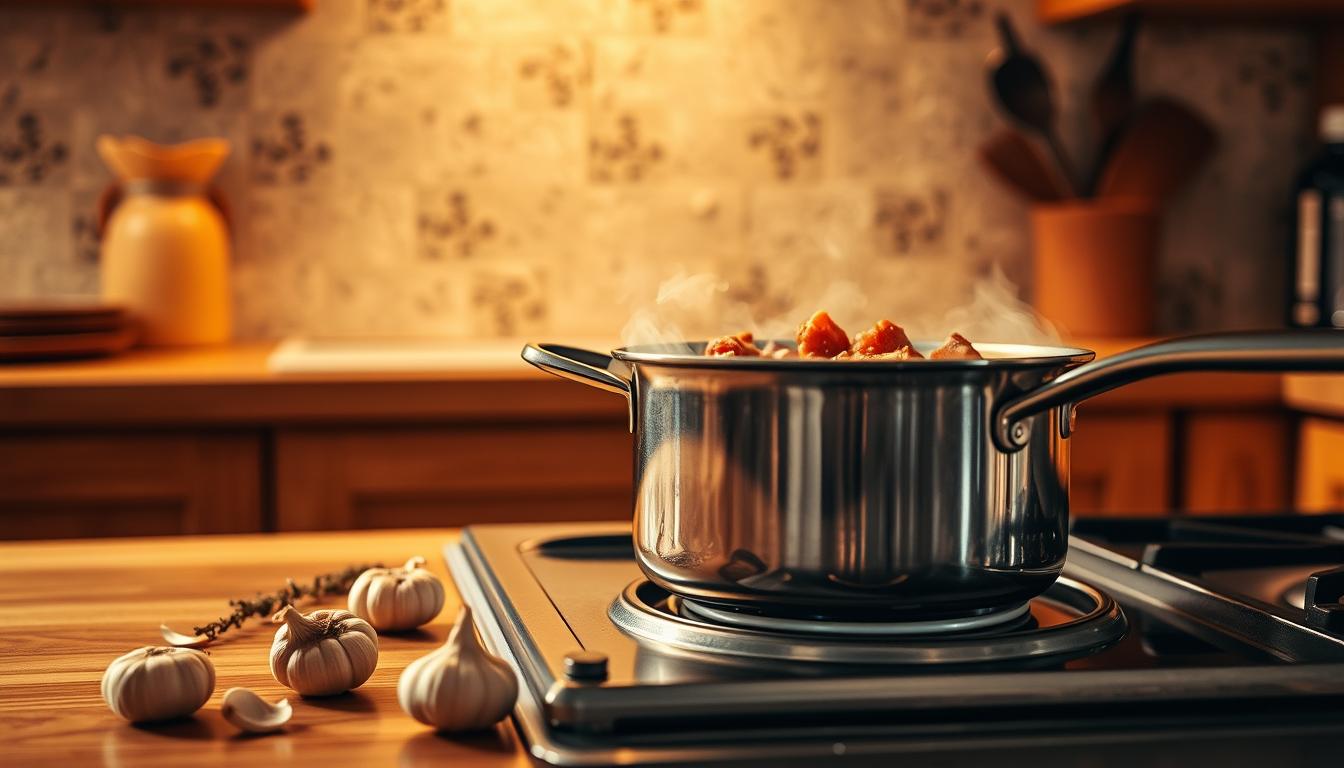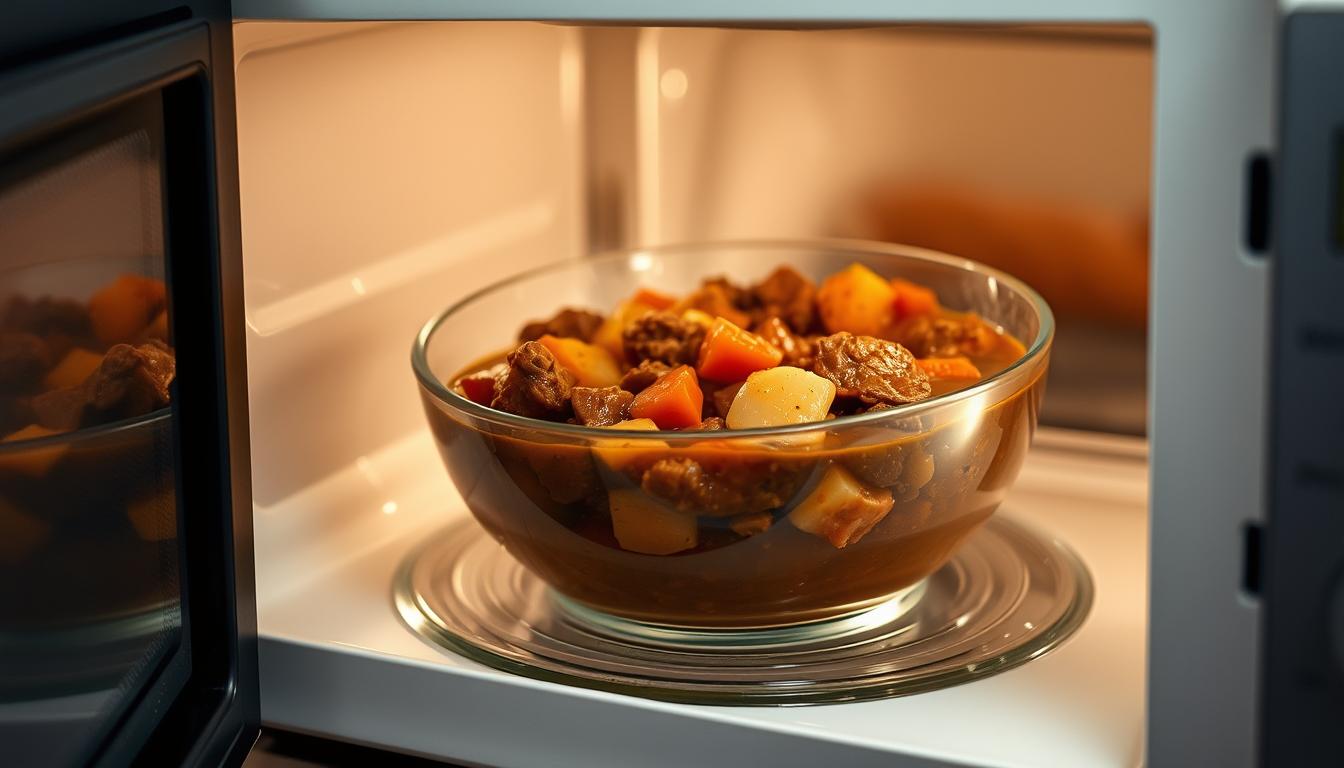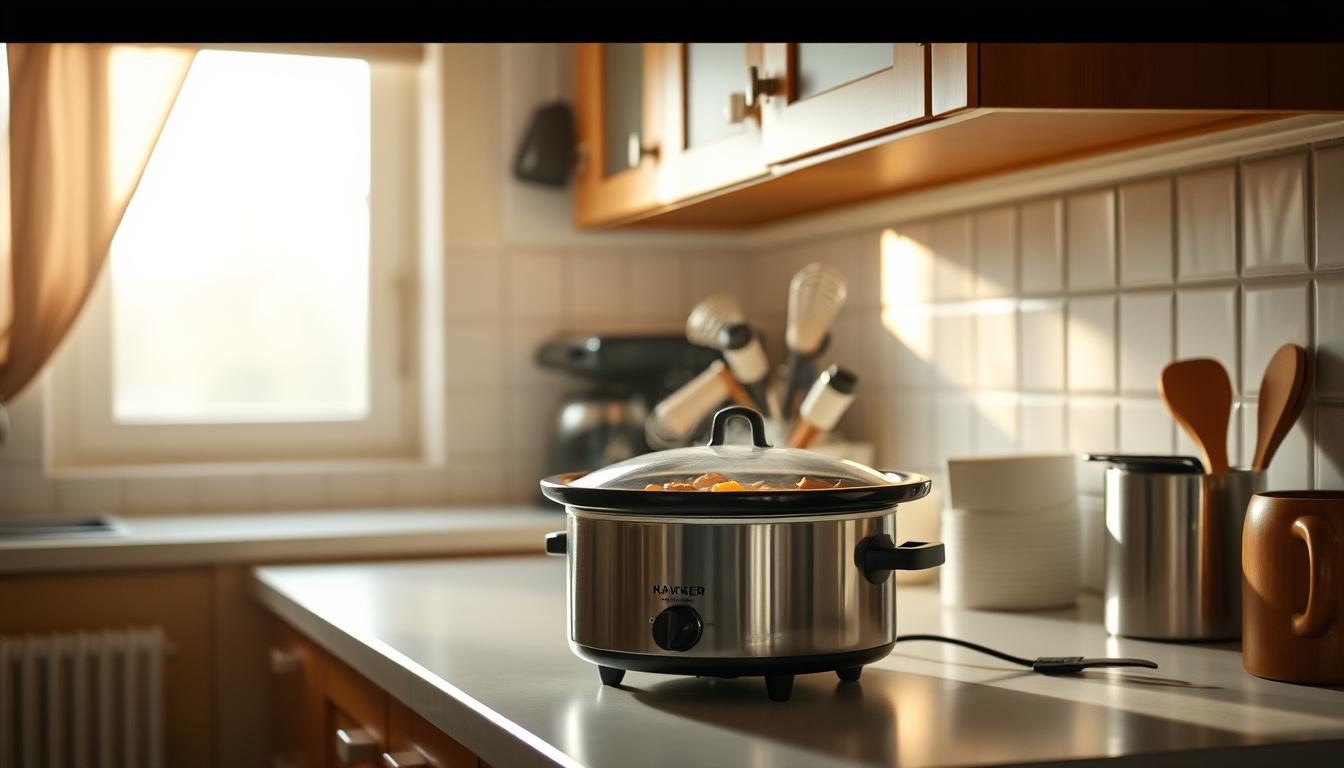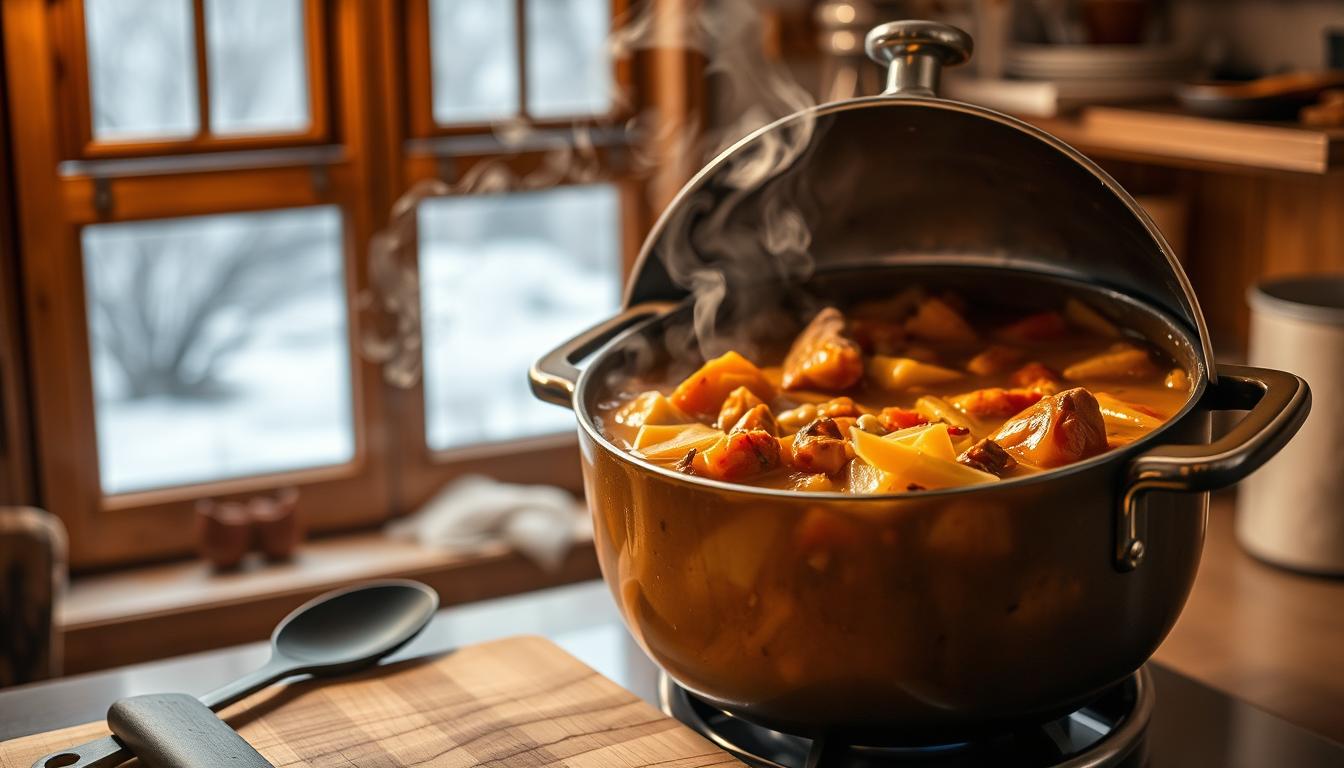Ever reheated a frozen stew and it tasted bad? Reheating frozen stew can be hard. But, with the right tricks, you can make it taste great.

It’s important to reheat frozen stew right to keep its taste and texture. Done well, it’s as good as eating it fresh. We’ll show you the best ways to reheat frozen stew.
Key Takeaways
- Safe reheating methods to prevent foodborne illness
- Tips for maintaining the stew’s flavor and texture
- Best practices for reheating frozen stew
- Common mistakes to avoid when reheating stew
- How to reheat stew to achieve the best flavor
Understanding the Challenges of Reheating Frozen Stew
Reheating frozen stew can be tricky. It’s not just about warming it up. You also want to keep its flavor and texture the same.
Why Stew Texture Changes When Frozen
Freezing stew can mess with its texture. Ice crystals form and can break down the ingredients. This is especially true for stews with veggies and starches, which can get mushy.
Common Issues When Reheating Frozen Stew
There are a few common problems. Some parts of the stew might be too hot, while others are cold. Also, it can get too thick or dry if not enough liquid is added.
Benefits of Proper Reheating Techniques
Using the right methods can solve these issues. Good reheating makes the stew hot all the way through. It keeps the moisture and flavor just right. This makes the stew taste better and is reheated safely.
Proper Preparation Before Reheating Frozen Stew
To get the best taste from reheating frozen stew, you must prepare it right. This means following a few steps to keep its flavor and texture the same.
Thawing Methods: When and How
First, thaw your frozen stew correctly. You can thaw it in the fridge overnight or in cold water. Change the water every 30 minutes. Safe thawing stops bacteria from growing.
When to Skip Thawing
Sometimes, you can reheat frozen stew straight from the freezer. This works well with microwaves or pressure cookers. Just remember to adjust the cooking time.
Portioning Considerations
Freeze your stew in portions before reheating. This makes it easier to heat only what you want. It saves energy and keeps the stew fresh.
Checking for Freezer Burn
Look at your stew for freezer burn before reheating. Freezer burn shows as dry, grayish spots. It doesn’t make the stew bad, but it can change how it tastes and feels.
How to Reheat Frozen Stew on the Stovetop
Reheating frozen stew on the stovetop is quick and tasty. It lets you control the heat. This makes sure your stew is hot and safe to eat.
Step-by-Step Instructions
First, put the stew in a pot. If it’s in a freezer-safe bag, move it to a pot or saucepan.
Then, turn the stovetop to medium-low heat. Heat the stew slowly to avoid burning or sticking.
Stir the stew often as it warms up. This spreads the heat evenly and stops hot spots.
Tips for Preventing Burning and Sticking
Stir the stew often to avoid burning or sticking. A non-stick pan is also helpful.
If the stew starts sticking, lower the heat. Add a bit of liquid if needed.
Ideal Heat Settings and Timing
The best heat for reheating stew is medium-low. It heats gently.
The time it takes to reheat depends on the stew’s size and coldness. Usually, it takes 20-30 minutes for a serving.
| Quantity of Stew | Reheating Time | Heat Setting |
|---|---|---|
| 1 serving | 15-20 minutes | Medium-Low |
| 2-3 servings | 25-35 minutes | Medium-Low |
| 4 or more servings | 40-50 minutes | Low |
When to Add Additional Liquid
If the stew is too thick, add a bit of liquid. Use broth, water, or wine, based on the recipe.
Adding liquid makes the stew’s consistency better. It also adds flavor.
By following these steps, you can enjoy a tasty, reheated stew like it’s fresh.
Reheating Frozen Stew in the Microwave
Microwave reheating is quick and easy. But, you must be careful to keep it safe and do it right.
Container Selection and Safety
Choose a safe container for your frozen stew. Make sure it says “microwave-safe” to avoid accidents. Glass and ceramic are good choices.
- Use microwave-safe glass or ceramic containers.
- Avoid metal containers or those with metal trim.
- Check for a “microwave-safe” label.
Power Settings and Timing Guidelines
Use a medium to low power setting to reheat safely. This prevents overheating and ensures even thawing. The time needed will vary based on the stew’s size and your microwave’s power. Start with 30 seconds, stir, and repeat until it’s hot.
Stirring Techniques for Even Heating
Stirring is important for even heating. Use a fork or spoon to gently mix the stew. This helps the heat spread evenly.
Covering Methods to Retain Moisture
Use a microwave-safe lid or plastic wrap to keep moisture in. But, watch out for plastic wrap. It can melt or release harmful chemicals. Leave a corner open to let steam out.

Using an Oven to Reheat Frozen Stew
The oven is a great way to reheat frozen stew. It keeps the flavor and texture just right. It’s perfect for warming up big batches.
Oven Temperature and Time Requirements
First, heat your oven to 300°F (150°C). The time needed depends on the stew’s size and if it’s covered. Usually, it takes 30-45 minutes for a big stew.
Best Containers for Oven Reheating
Use containers safe for the oven, like ceramic, glass, or stainless steel. Don’t use plastic or containers with plastic lids. They might melt or warp.
Preventing Moisture Loss
To keep moisture in, cover the container with aluminum foil or a safe lid. This keeps the stew’s moisture and taste.
Advantages for Large Portions
Reheating big batches of frozen stew in the oven is easy and works well. It heats the stew evenly without stirring. It’s great for meal prep or feeding many people.
Some key benefits of oven reheating include:
- Even heating throughout the stew
- Less risk of drying out the stew when covered properly
- The ability to reheat large quantities at once
Slow Cooker Method for Reheating Frozen Stew
The slow cooker method is easy and works well for reheating frozen stew. It’s great for those who like to cook without much effort.
When to Use This Method
Use a slow cooker when you’re in a hurry or like cooking slowly. It’s best for big portions.
Safety Considerations
Make sure your stew is hot enough. Use a food thermometer to check it’s at least 165°F (74°C).

Time and Temperature Settings
Reheat frozen stew in a slow cooker on low for 4-6 hours. Or on high for 2-3 hours. Adjust time based on the stew’s start temperature and your cooker’s power.
Benefits for Flavor Development
The slow cooker method makes flavors blend well. It also makes the stew tender and tastier.
Using a Pressure Cooker or Instant Pot for Frozen Stew
Using a pressure cooker or Instant Pot is a quick and safe way to reheat frozen stew. It saves time and keeps the stew’s flavor and texture.
Advantages of Pressure Cooking
Pressure cooking is fast for reheating frozen stew. It seals the stew in a pressurized space. This allows for hot temperatures that reheat the stew quickly and evenly.
Step-by-Step Instructions
To reheat frozen stew in a pressure cooker or Instant Pot, follow these steps:
- Place the frozen stew in the pressure cooker or Instant Pot.
- Add a small amount of liquid if necessary to prevent scorching.
- Close the lid and set the valve to ‘sealing.’
- Cook on high pressure for 5-10 minutes, depending on the stew’s thickness and your desired temperature.
- Allow the pressure to release naturally or quick-release it.
Time-Saving Benefits
Using a pressure cooker or Instant Pot makes reheating faster than other methods. It’s great when you’re in a hurry but want a hot, home-cooked meal.
Adjusting Settings for Different Stew Types
Different stews may need different cooking times or liquids. Thicker stews might need more liquid or longer cooking. Thinner stews can be reheated quicker.
How to Maintain Flavor and Texture When Reheating Stew
Reheating frozen stew needs some easy steps. Use the stovetop, microwave, oven, or slow cooker. The goal is to reheat it gently and fix its quality.
Adding Fresh Ingredients
Adding fresh stuff can make reheated stew taste better. Try adding fresh herbs like parsley or thyme. A squeeze of lemon juice or vinegar can also help.
- Fresh herbs (parsley, thyme, etc.)
- Lemon juice or vinegar
- Fresh vegetables (if appropriate)
Seasoning Adjustments
Check the stew’s taste as you reheat it. You might need to add salt, pepper, or spices. Frozen and reheated foods can lose flavor.
Thickening Techniques
If your stew is too watery, you can fix it. Here are a few ways:
- Mix cornstarch or flour with water or broth. Stir it into the stew.
- Simmer the stew a bit longer to reduce the liquid.
- Add a roux (flour and fat mix) to thicken it.
Restoring Vegetable Texture
To keep veggies in stew fresh, add new ones near the end. Or, sauté or steam extra veggies before adding them.
Safety Guidelines for Reheating Frozen Stew
When you reheat frozen stew, safety comes first. You must be careful to avoid health risks. Reheating frozen stew needs your full attention to do it right.
Internal Temperature Requirements
Heat the stew to 165°F (74°C) to kill bacteria. Use a food thermometer, especially in thick parts.
Signs of Spoilage to Watch For
Check for off smells, slimy texture, or mold before reheating. If you see these, throw the stew away.
Maximum Storage Times
Frozen stew stays safe for 3 to 4 months at 0°F (-18°C). Keep track of storage time to stay safe.
Proper Cooling and Storing Practices
Cool leftovers to room temperature in two hours. Then, refrigerate or freeze them fast. This stops bacteria and keeps the stew good.
Follow these safety tips to enjoy your reheated stew safely. The best way to reheat is on the stovetop or microwave, but watch it closely.
Special Considerations for Different Types of Stew
When reheating stew from frozen, you need to think about its type. This includes meat, vegetable, seafood, or cream-based stews. Each type has its own way to reheat best.
Meat-Based Stews
Stews with meat, like beef or lamb, need gentle reheating. This keeps the meat soft. Reheat them slowly on the stovetop or in the oven.
Vegetable and Vegan Stews
Vegetable and vegan stews are easier to reheat. But, to keep their taste and texture, reheat them quickly. Use medium heat and stir often.

Seafood Stews
Seafood stews are very sensitive to heat. To avoid overcooking, reheat them gently. Use the microwave or low heat on the stovetop.
Cream-Based Stews
Cream-based stews need special care when reheating. To keep the cream smooth, reheat over low heat. Stir constantly while reheating.
Knowing how to reheat different stews makes your meal better. Whether it’s a hearty meat stew or a light seafood stew, follow these tips. You’ll enjoy a great meal every time.
Enhancing Your Reheated Stew
Make your leftover stew special with a few easy steps. Reheating is just the start. What you do next can make it even better.
Fresh Herbs and Garnishes
Adding fresh herbs like parsley, thyme, or rosemary can make your stew taste and look better. Try adding a sprinkle of fresh herbs just before you serve it. It adds a fresh touch.
Complementary Side Dishes
Choosing the right side dishes can make your meal complete. Here are some good options:
- Crusty bread for dipping
- Roasted vegetables for added texture
- Mashed potatoes for a comforting combination
| Side Dish | Description | Preparation Time |
|---|---|---|
| Crusty Bread | Perfect for dipping into the stew’s broth | 10 minutes |
| Roasted Vegetables | Adds a nice contrast in texture | 20-30 minutes |
| Mashed Potatoes | A comforting side that pairs well with stew | 30-40 minutes |
Creating New Meals from Leftover Stew
You can turn leftover stew into new dishes. For example, use it in wraps or on top of baked potatoes.
Serving Suggestions
Make your stew look good when you serve it. Try using garnishes or serving it in a bread bowl for a rustic look.
Conclusion
Reheating frozen stew is easy if you know how. You’ve learned many ways to do it, like using the stovetop, microwave, or oven. You can also use a slow cooker, pressure cooker, or Instant Pot.
Each method has its own good points. The best way to reheat stew depends on what you like and what you have.
To get the best taste and texture, think about thawing, portioning, and how to reheat. This way, your stew will stay delicious. It doesn’t matter if it’s meat, vegetable, or seafood stew. Just make sure it’s hot enough.
With these tips, you can enjoy your frozen stew safely and well. Next time you wonder how to reheat it, you’ll know exactly what to do.
FAQ
What is the best way to reheat frozen stew?
You can reheat frozen stew in many ways. Try the stovetop, microwave, oven, slow cooker, or Instant Pot. Each method has its own tips for safe and even heating.
How do I prevent my stew from drying out when reheating?
To keep your stew moist, add a bit of liquid like broth. Covering it while it heats up helps too. Stirring now and then keeps it moist and evenly heated.
Can I reheat frozen stew without thawing it first?
Yes, you can reheat frozen stew without thawing. Just make sure it gets hot enough to avoid sickness. The stovetop, oven, and pressure cooker work well with frozen stew. But, the microwave and slow cooker might need thawing or careful watching.
What is the safe internal temperature for reheated stew?
Reheated stew should be at least 165°F (74°C). Always check the thickest parts to make sure it’s hot enough.
How can I reheat frozen stew in the microwave?
Put frozen stew in a microwave-safe dish. Cover it with a safe lid or plastic wrap. Heat on 50-60% power, stirring every 30 seconds until it’s 165°F (74°C).
Can I use a slow cooker to reheat frozen stew?
Yes, a slow cooker works for reheating stew. But, thaw it first or make sure it gets hot enough quickly. Use the high setting for faster heating.
How do I check if my frozen stew has gone bad?
Look for signs of spoilage like bad smells, slimy texture, or mold. If it’s been stored too long, it’s safer to throw it away.
What are the benefits of using a pressure cooker or Instant Pot to reheat stew?
Pressure cookers or Instant Pots reheat stew fast and keep it tasty. They’re great for big batches.
How can I enhance the flavor of reheated stew?
Add fresh herbs or adjust the seasoning to boost flavor. A side dish or garnish can also make it better.
